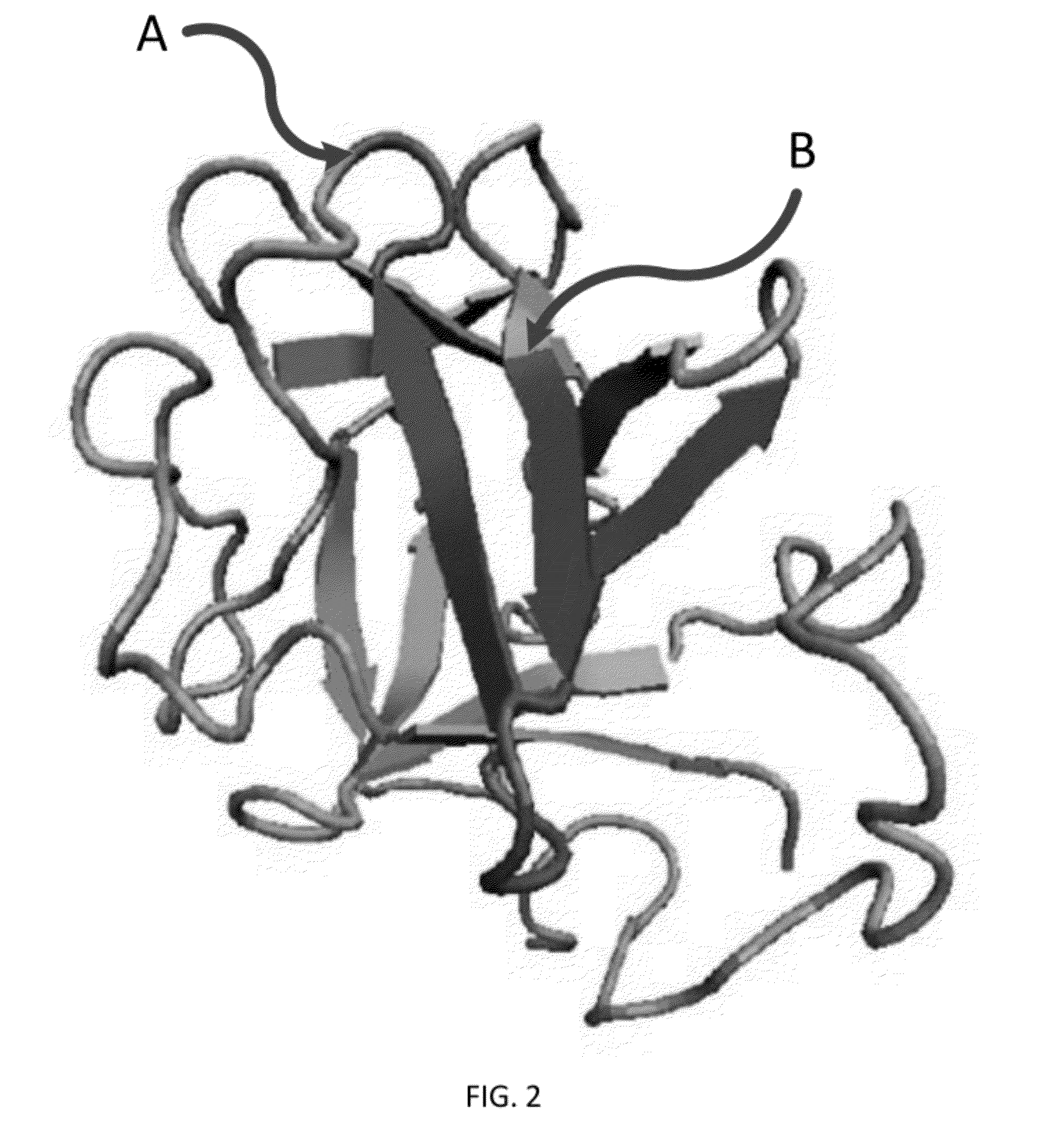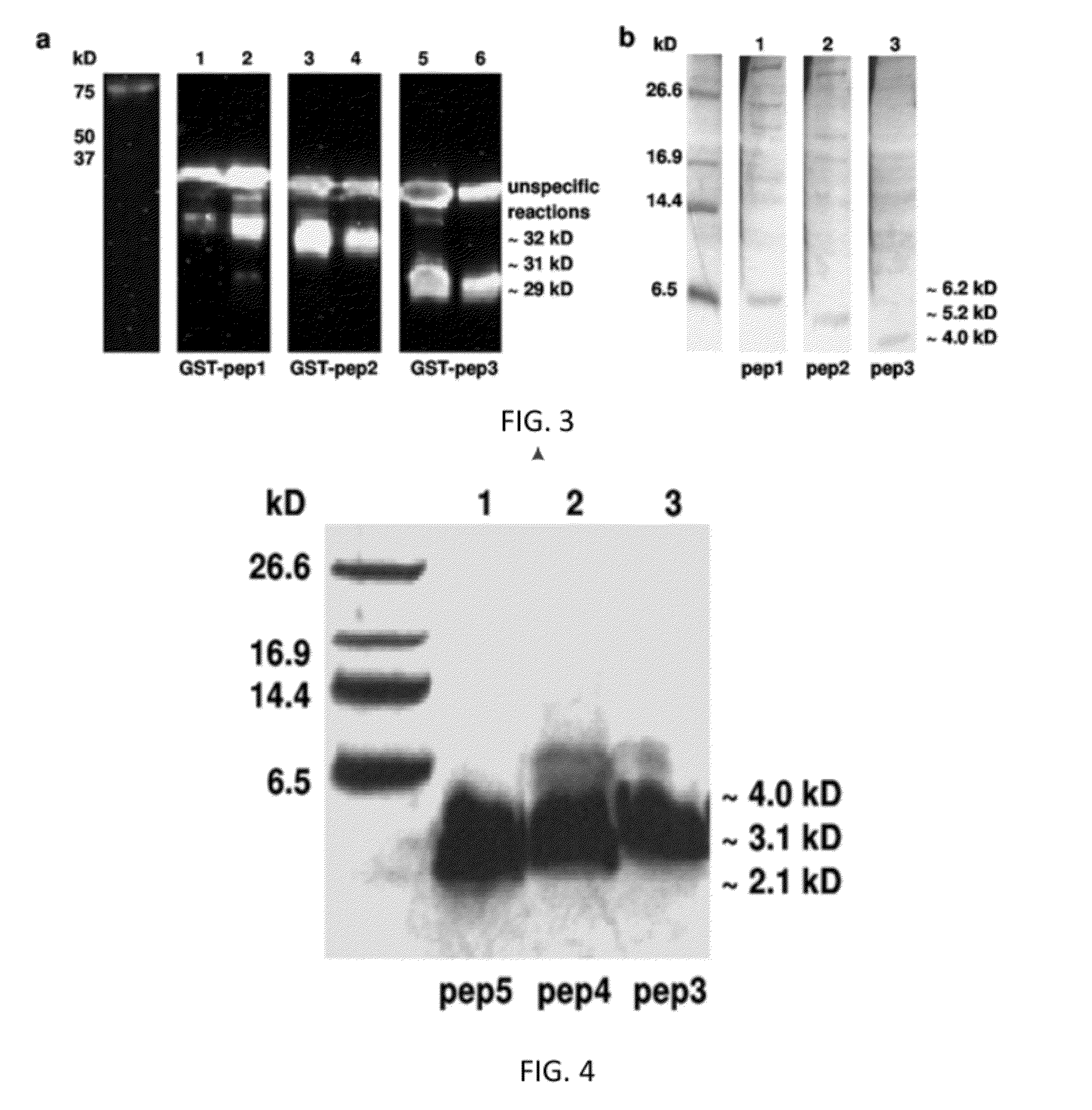FGF based fibrin binding peptides
- Summary
- Abstract
- Description
- Claims
- Application Information
AI Technical Summary
Benefits of technology
Problems solved by technology
Method used
Image
Examples
example 1
a) Construction of hFGF-2 and Various Truncated hFGF-2 Expression Plasmids
[0073]Using a standard PCR program (95° C., 30 sec; 60° C., 30 sec; 72° C., 30 sec; 25 cycles), full length hFGF-2 cDNA was amplified with primers containing EcoRI and XhoI restriction sites and a HIS-tag (6×) on the C-terminus (Table 1).
TABLE 1 Primers containing EcoRI and XhoI restriction sites were used forsubcloning full length hFGF-2 cDNA and hFGF-2 cDNA fragments into pGEX-6P-2expression vector. The restriction sites are inderlined and the 6x HIS-tagon the C-terminus is marked in italics. The sequences of the synthetic peptides #3, #4, and #5 contain a 5x HIS-tag at the C-terminus (italics).Primerssense (s) and antisense (as); 5′-3′EcoR I restriction sitehbFGF full length senseGGA ATT CCC ATG GCA GCC GGG AGC ATC (SEQ ID NO: 8)hbFGF pep1 senseGGA ATT CCC GAA GAG AGA GGA GTT GTG (SEQ ID NO: 9)hbFGF pep2 senseGGA ATT CCC GTG TGT GCT AAC CGT TAC (SEQ ID NO: 10)Xho I restriction sitehbFGF full lengthCTC GAG T...
example 2
[0086]Aprotinin was successfully covalently bound to one FS-anchor (His-FGF-2, pep1 (68 an), pep3 (37 aa) and pep4 (28 aa)) using a standard protocol for 1-ethyl-3-(3-dimethylaminopropyl)carbodiimide) (EDC) coupling (FIG. 8A). For a positive control recombinant human FGF-2 (ProSpec Tany, Israel) and for a negative control phosphate buffered saline (PBS) were used. Covalently linked to a FS-anchor and purified aprotinin was mixed with fibrinogen and finally with thrombin to form fibrin clots. These fibrin clots were kept in PBS at 37° C. to observe stability and degradation of fibrin. After 5 days fibrin clots with the pep3 and pep4 FS-anchor showed a higher stability as die fibrin clots with His-FGF-2 and pep1 (FIG. 5B).
Discussion
[0087]It was the aim to produce biological active hFGF-2 peptides with a binding affinity to fibrinogen and fibrin. hFGF-2 peptides as well as foil length hFGF-2 were recombinantly expressed and purified. Human FGF-2 is a single chain polypeptide without an...
PUM
| Property | Measurement | Unit |
|---|---|---|
| Length | aaaaa | aaaaa |
| Biological properties | aaaaa | aaaaa |
| Stability | aaaaa | aaaaa |
Abstract
Description
Claims
Application Information
 Login to View More
Login to View More - R&D
- Intellectual Property
- Life Sciences
- Materials
- Tech Scout
- Unparalleled Data Quality
- Higher Quality Content
- 60% Fewer Hallucinations
Browse by: Latest US Patents, China's latest patents, Technical Efficacy Thesaurus, Application Domain, Technology Topic, Popular Technical Reports.
© 2025 PatSnap. All rights reserved.Legal|Privacy policy|Modern Slavery Act Transparency Statement|Sitemap|About US| Contact US: help@patsnap.com



